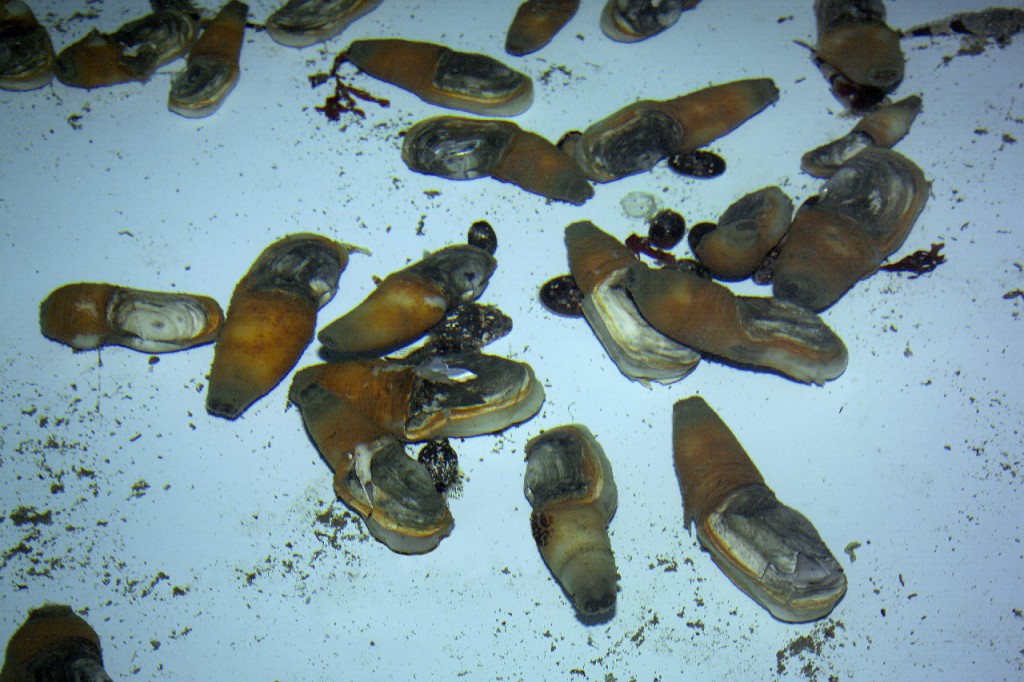
This image is associated with the 2005-2010 BAS science programme: BIOFLAME – Biodiversity, Function, Limits and Adaptation from Molecules to Ecosystems.
Age matters to Antarctic clams
A new study of Antarctic clams reveals that age matters when it comes to adapting to the effects of climate change. The research provides new insight and understanding of the likely impact of predicted environmental change on future ocean biodiversity.
Reporting this week in the journal Global Change Biology scientists from British Antarctic Survey (BAS) and from Germany’s University of Kiel and the Alfred Wegener Institute reveal that when it comes to environmental change the reaction of Antarctic clams (laternula elliptica) – a long-lived and abundant species that lives in cold, oxygen-rich Antarctic waters – is different depending on how old the animal is.
The study showed that whilst young clams (average of three years old) try to move to a better area in the sea-bed sediments when they sense warmer temperature or reduced oxygen levels, the older (18 years old) more sedentary clams stay put. This has implications for future clam populations because it is the older animals that reproduce. Scientists anticipate that future oceans will be slightly warmer and contains less oxygen (a condition known as hypoxia).
Lead Author Dr Melody Clark of British Antarctic Survey said,
“Antarctic clams play a vital role in the ocean ecosystem. They draw down carbon into sea-bed sediments and circulate ocean nutrients. We know that they are extremely sensitive to their environment. Our study suggests that the numbers of clams that will survive a changing climate will reduce.
“The Polar Regions are the Earth’s early warning system and Antarctica is a great natural laboratory to study to future global change. These small and rather uncharismatic animals can tell us a lot about age and survival in a changing world – they are one of the ‘engines of the ocean’.”
Co-author, Eva Phillip, from the University of Kiel, says:
“The study shows that it is important to investigate different ages of a population to understand population wide changes and responses. In respect to Antarctic clams it has been indicated in previous studies that older individuals may suffer more severely in a changing environment and the new study corroborates this assumption. Only the investigation of population-wide effects makes it possible to draw conclusions for coastal ecosystems.”
Like humans, clams’ muscle mass decreases as they get older. This means they get more sedentary. So when changes are introduced into their habitat, the older clams tend to just sit it out until conditions revert back to normal.
Doris Abele of the Alfred Wegener Institute in Germany says:
“Our study shows that the physiological flexibility of young clams diminishes as they get older. However, the species has evolved in such a way that the fittest animals, that can tolerate life in an extreme environment, survive to reproduce into old age. Climatic change, affecting primarily the older clams, may interfere with this evolutionary strategy, with unpredictable consequences for ecosystems all around Antarctica.”
The research was funded by the Natural Environment Research Council, the German Research Foundation and the European Science Foundation.
Clams in the BAS Aquarium
Get the Flash Player to see this player.
ENDS
Issued by the British Antarctic Survey Press Office.
Contact:
Paul B. Holland, Tel: +44 (0)1223 221226; Mob: + 44 07740822229; email: pbmho@bas.ac.uk
Scientist contact details:
Dr Melody Clark, British Antarctic Survey. Te; 01223 221371; mob: 07980 988420; email: mscl@bas.ac.uk
Doris Abele, Alfred-Wegener-Institute for Polar and Marine Research Am Handelshafen. Tel: +49-471-4831-1567; mob: +49-0151-10411535; email: Doris.Abele@awi.de
Eva Phillip, University of Kiel. Email. e.philipp@ikmb.uni-kiel.de
Notes for editors
The paper Hypoxia impacts large adults first: consequences in a warming world, is published by Global Change Biology on 18 April 2013.
Video footage/stills are available from the British Antarctic Survey Press Office.
Antarctic clams (laternula elliptica) can live up to 36 years, and produce their offspring during their mature years. . They have evolved in stable temperatures over many centuries.
Around the Antarctic Peninsula the sea temperature has risen by 1°C over the last fifty years. It is likely that as warming increases the amount glacier material that makes its way to the seabed will affect clams and other marine animals that live in the sea-bed sediments.
A selection of young clams (average of three years old) and older ones (around 18 years) were collected by divers off King George Island and BAS Rothera Research Station on the Antarctic Peninsula. The animals were then placed in aquarium tanks to simulate different environmental conditions and to test the clams’ reaction to variations in oxygen and nitrogen levels. They found that younger clams were more active in their reaction to hypoxia.
